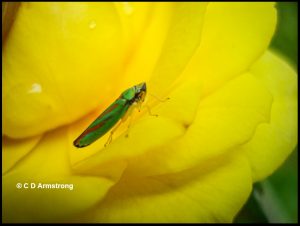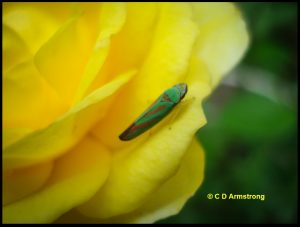Candy-striped / Red-banded Leafhopper


The brilliantly colored Candy-striped leafhopper (Graphocephala coccinea) is one of the most common leafhoppers of North America’s roughly 2500 leafhopper species. It is native to North and Central America, extending from Canada south to Panama. It goes by several additional common names, including the Red-banded leafhopper, Scarlet-and-green leafhopper, and Red-and-blue leafhopper. It has a particular fondness for blackberry and raspberry leaves, but may also be found on the leaves of a variety of ornamental plants including roses and rhododendrons (There is a very similar one in the same genus called the Rhododendron Leafhopper, Graphocephala fennahi, which feeds exclusively on rhododendron). The leafhoppers’ eggs are laid in the leaves.
This leafhopper, unfortunately, is one of several other leafhopper species that has been found to be a vector of a bacterium that can cause a leaf scorch disease known as “Pierce’s disease.” The disease has been implicated in the decline of elm, oak, and other ornamental trees. At least three subspecies of this leafhopper have been named: G. coccinea confluenta, G. coccinea punctata, and G. coccinea sambuci.
Additional Photos & Information:
- Candy-striped leafhoper (University of Wisconsin)
- Images from the Graphocephala genus (BugGuide.net)
- Rhododendron Leafhopper (very similar in appearance to the Candy-striped Leafhopper) (BugGuide.net)
